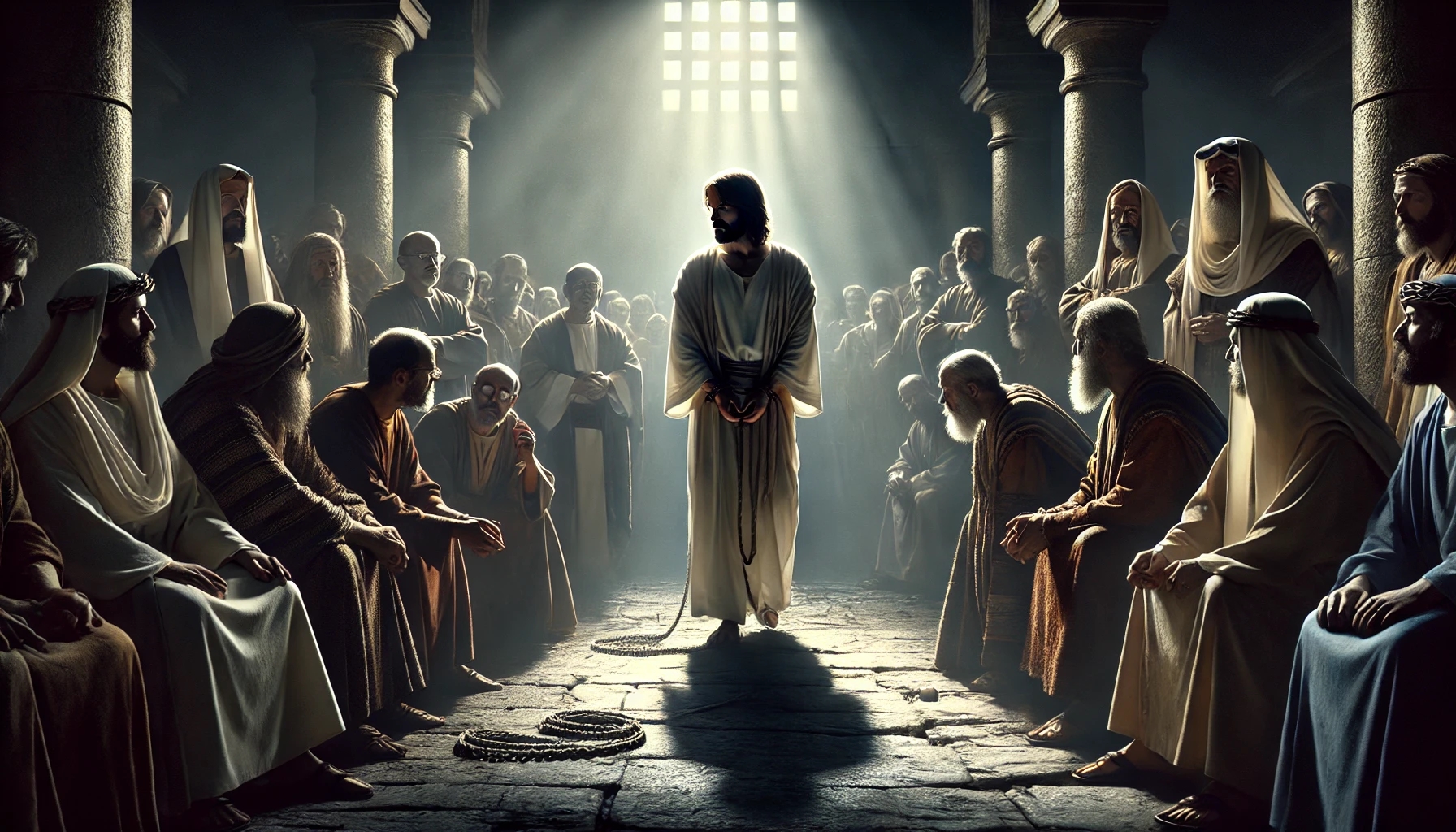November 18, 2024
DAILY BIBLE READING – Acts Chapter 22
1 Men, brethren, and fathers, hear ye my defence which I make now unto you.
2 (And when they heard that he spake in the Hebrew tongue to them, they kept the more silence: and he saith,)
3 I am verily a man which am a Jew, born in Tarsus, a city in Cilicia, yet brought up in this city at the feet of Gamaliel, and taught according to the perfect manner of the law of the fathers, and was zealous toward God, as ye all are this day.
4 And I persecuted this way unto the death, binding and delivering into prisons both men and women.
5 As also the high priest doth bear me witness, and all the estate of the elders: from whom also I received letters unto the brethren, and went to Damascus, to bring them which were there bound unto Jerusalem, for to be punished.
6 And it came to pass, that, as I made my journey, and was come nigh unto Damascus about noon, suddenly there shone from heaven a great light round about me.
7 And I fell unto the ground, and heard a voice saying unto me, Saul, Saul, why persecutest thou me?
8 And I answered, Who art thou, Lord? And he said unto me, I am Jesus of Nazareth, whom thou persecutest.
9 And they that were with me saw indeed the light, and were afraid; but they heard not the voice of him that spake to me.
10 And I said, What shall I do, Lord? And the Lord said unto me, Arise, and go into Damascus; and there it shall be told thee of all things which are appointed for thee to do.
11 And when I could not see for the glory of that light, being led by the hand of them that were with me, I came into Damascus.
12 And one Ananias, a devout man according to the law, having a good report of all the Jews which dwelt there,
13 Came unto me, and stood, and said unto me, Brother Saul, receive thy sight. And the same hour I looked up upon him.
14 And he said, The God of our fathers hath chosen thee, that thou shouldest know his will, and see that Just One, and shouldest hear the voice of his mouth.
15 For thou shalt be his witness unto all men of what thou hast seen and heard.
16 And now why tarriest thou? arise, and be baptized, and wash away thy sins, calling on the name of the Lord.
17 And it came to pass, that, when I was come again to Jerusalem, even while I prayed in the temple, I was in a trance;
18 And saw him saying unto me, Make haste, and get thee quickly out of Jerusalem: for they will not receive thy testimony concerning me.
19 And I said, Lord, they know that I imprisoned and beat in every synagogue them that believed on thee:
20 And when the blood of thy martyr Stephen was shed, I also was standing by, and consenting unto his death, and kept the raiment of them that slew him.
21 And he said unto me, Depart: for I will send thee far hence unto the Gentiles.
22 And they gave him audience unto this word, and then lifted up their voices, and said, Away with such a fellow from the earth: for it is not fit that he should live.
23 And as they cried out, and cast off their clothes, and threw dust into the air,
24 The chief captain commanded him to be brought into the castle, and bade that he should be examined by scourging; that he might know wherefore they cried so against him.
25 And as they bound him with thongs, Paul said unto the centurion that stood by, Is it lawful for you to scourge a man that is a Roman, and uncondemned?
26 When the centurion heard that, he went and told the chief captain, saying, Take heed what thou doest: for this man is a Roman.
27 Then the chief captain came, and said unto him, Tell me, art thou a Roman? He said, Yea.
28 And the chief captain answered, With a great sum obtained I this freedom. And Paul said, But I was free born.
29 Then straightway they departed from him which should have examined him: and the chief captain also was afraid, after he knew that he was a Roman, and because he had bound him.
30 On the morrow, because he would have known the certainty wherefore he was accused of the Jews, he loosed him from his bands, and commanded the chief priests and all their council to appear, and brought Paul down, and set him before them.
King James Version. Public Domain
Commentary
Introduction
Acts Chapter 22 describes the Apostle Paul’s defense speech before an agitated Jewish crowd in Jerusalem. Paul seizes the opportunity to recount his conversion story and his mission as a witness of Christ. He emphasizes his Jewish heritage, his zeal for the Law, and his dramatic encounter with Jesus on the road to Damascus. The chapter illustrates how Paul, despite facing resistance and persecution, steadfastly defends his calling while simultaneously exercising his Roman rights to avoid further mistreatment.
Commentary
Paul’s speech is a powerful testimony of his conversion and his apostolic mission. By choosing to speak in Hebrew and emphasizing his Jewish background, he attempts to build a bridge with his audience. His narrative demonstrates how his life was radically transformed by his encounter with Christ. Particularly impressive is the role of Ananias, who calls Paul to baptism and commissions him into service for God.
Paul also reveals his former hostility toward Christians and confesses his involvement in persecuting believers like Stephen. This openness serves not only as a self-accusation but also underscores the transformative power of the Gospel. However, mentioning his mission to bring the Gospel to the Gentiles provokes the crowd and leads to renewed uproar.
The interaction with the Roman authorities shows how Paul wisely uses his citizenship rights to avoid mistreatment. His reference to his Roman citizenship puts the commander in a difficult position, preventing further flogging. This passage illustrates both Paul’s courage and his strategic wisdom in dealing with political and religious opposition.
Summary
In Acts Chapter 22, Paul defends himself before the Jewish crowd in Jerusalem by outlining his background, his conversion, and his divine mission. He recounts his encounter with Jesus on the road to Damascus and his calling to preach the Gospel. The crowd becomes particularly enraged when Paul speaks of his mission to the Gentiles.
As the situation escalates, the Roman authorities intervene. Paul is bound and is about to be flogged, but he prevents this by invoking his Roman citizenship. The Roman commander is startled by this revelation and treats Paul more cautiously. The next day, Paul is brought before the Jewish Sanhedrin, where the investigation of his case continues.
The chapter highlights Paul’s steadfastness and unwavering faith, even in the face of intense opposition. At the same time, it underscores the tensions between the various political and religious groups that shaped his life and ministry.
![]()

WEEKLY SPIRIT OF PROPHECY READING – Ellen White | The Desire of Ages
Chapter 76—Judas
Read online here
Commentary
Introduction
Chapter 76 on Judas depicts the tragic story of a man who, despite his closeness to Jesus Christ and his privileged position among the Twelve, experienced the deepest fall. The text shows Judas’ initial enthusiasm for the Lord, his gradual surrender to greed, and his betrayal, which became the epitome of doom. His story is not only a tale of betrayal but also a serious warning about the danger of misusing divine gifts and opportunities.
Commentary
The story of Judas is a shocking example of how clinging to sin can render proximity to Jesus fruitless. Judas was called by Jesus and equated with the other disciples, even entrusted with the responsibility of treasurer. Despite all the miracles he saw and the words he heard, he did not allow himself to be completely changed by Christ. His love for money and his pride prevailed.
Especially striking is Judas’ apparent dedication, while he internally harbored doubts and resentment. His betrayal did not begin with handing over Jesus for thirty pieces of silver, but with small decisions that fueled his greed. The story illustrates how an unresolved weakness can become a destructive force.
Judas’ final desperate attempt to undo the consequences of his betrayal shows no true remorse but rather fear of the consequences. His tragic realization that it was “too late” underscores the seriousness of decisions that shape our hearts and determine our lives.
Summary
Chapter 76 traces the life and fall of Judas, from his calling by Jesus to his betrayal and tragic death. Judas began as a committed disciple who followed Jesus and heard his message. However, his love for money and his pride prevented him from fully surrendering to Christ. These weaknesses ultimately led him to betray Jesus for thirty pieces of silver.
Although Judas had numerous opportunities to repent, he remained trapped in his pride and greed. Even when Jesus revealed his betrayal at the Last Supper, he did not change his course. His attempt to return the money showed no genuine remorse, only fear of damnation. His life ended in despair and suicide.
The story of Judas is a serious admonition to keep the heart with God and not to be led by unresolved sins. It shows how a seemingly small weakness, if left unchecked, can lead to catastrophic consequences.
Source: https://fulfilleddesire.net/18-11-2024-acts-chapter-22-believe-his-prophets/









